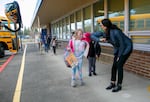School districts all over the Pacific Northwest and across the country are dealing with staffing shortages in multiple areas.
From bus drivers to paraeducators to substitute teachers, already understaffed schools are looking to current staff to help fill roles — a stretch that gets even tougher if teachers have to quarantine because of a COVID-19 exposure. According to the Bureau of Labor Statistics, public schools and universities nationally fell short of typical hiring goals by 161,000 jobs in September “as they struggled to find enough workers as the school year started.”

Teacher Stacie Walczyk, left, works with Alexandra Villegas-Lopez in class at Ellsworth Elementary School in Vancouver, Wash., earlier this spring. Many school districts in the Pacific Northwest and across the country are struggling with a shortage of teachers and substitute teachers.
Kristyna Wentz-Graff / OPB
Though district officials expect openings to increase now that Gov. Kate Brown’s vaccine mandate is in effect, the level of shortages in schools started before October 18 and will continue afterwards.
For Portland Public Schools, several departments have openings.
In a message to members last week, Portland Association of Teachers president Elizabeth Thiel said PPS’ staffing issues pre-date the pandemic.
“It’s a reflection of our unsustainable working conditions and the deterioration of student supports in our schools,” Thiel wrote.
She noted 146 certified positions are posted and unfilled in the district, as well as a substantial shortage in substitute teachers.
“Between September 1 and October 5, there were a total of 1,326 unfilled substitute jobs,” according to Thiel, referring to the number of needed assignments that went without a substitute. In the same time period during the 2019-2020 school year, there were only 164 unfilled assignments.
Statewide, in issuing an emergency substitute teaching license for the next six months, the Teacher Standards and Practices Commission said Oregon’s substitute shortage is severe. Part of the problem, according to TSPC, is a steep drop in the number of available subs.
”In December 2019 (pre-COVID), Oregon had 8,290 licensed substitute teachers,” according to the order. “As of September 18, 2021, that number is down to 4,738.”
PPS said it plans to sponsor applications for emergency substitute teachers.
PPS, like other districts, is also understaffed when it comes to transportation workers, like bus drivers. That has resulted in a high number of constantly changing or cancelled routes. To help hire and retain employees in the transportation department, the school board voted last week to increase wages by $3 per hour for the current school year.
PPS officials say they are also putting together referral and retention bonuses for some other positions, which they plan to finalize this week.

Many school districts are increasing pay to keep bus drivers and hire more as the pandemic has led to shortages. Some districts are also looking at bonuses to lure applicants for a variety of jobs, as well as retention bonuses to keep the staff they have.
Kaylee Domzalski / OPB
One area in particular where educators are feeling the lack of a full staff is in special education classrooms, or in school-based positions supporting students with disabilities. Thiel’s PAT message notes there are almost 80 open positions for paraeducators and educational assistants — essential staff that help support students with disabilities.
“We know that the district is actively recruiting paraeducators, but the pool is just not there right now,” said Mary Darin, a speech language pathologist at Buckman Elementary School in Southeast Portland.
“But this also is an ongoing [problem] — the pandemic brought it all to light, but this is not new.”
Darin said she has talked to paraeducators who were considering quitting their jobs to apply for the emergency substitute license, positions that usually pay more.
In some schools, district or school administrators are having to cover understaffed classrooms, or paraeducators are being shuffled around, all in classrooms serving students with significant disabilities.
“It’s all over the place, and even when our principal is the one that’s supporting the class, because of the trauma from the pandemic, we have a lot of kids who have really high behaviors in almost every single grade level,” said Alisha Chavez-Downing, an intensive skills classroom teacher at Southeast Portland’s Atkinson Elementary. “And so, we don’t have anyone to come and support teachers if a kid needs to go take a break somewhere outside of the classroom.”
Chavez-Downing said the district should have a plan in place to clarify the point at which understaffing may create an unsafe environment for students, so teachers can shift to distance learning in that situation.
“Why are you sending kids to school like that when you know it is unsafe for them to be there with that amount of support?” Chavez said.
Darin said special educators and speech language pathologists around the district have been pulled away from their typical caseloads. They’re instead having to react to safety concerns or behavior issues. The staffing shuffle ultimately affects students who have returned to school with varying needs and skills — and need skilled staff to provide the proper support.
“Students aren’t getting the right curriculum at their level, or getting the right social emotional supports at their level,” Darin said.
Beaverton is in a situation similar to PPS, with numerous openings for bus drivers, nutrition service workers, custodians, and paraeducators. There are 400 current openings for classified school support substitutes, according to the district.

A student touches elbows with a teacher as she leaves school at Ellsworth Elementary School in Vancouver, Wash., earlier this spring. A shortage of teachers and substitute teachers has put a strain on trying to get a teacher in every classroom, forcing administrators to sometimes fill in as teachers.
Kristyna Wentz-Graff / OPB
To help hire and retain employees, Beaverton officials have announced a $500 bonus for new hires in those departments, as well as a $500 retention bonus for employees already working in those roles.
The district is also seeking hundreds of licensed substitute teachers, though at the moment, they would not receive the hiring bonus.
In Portland and in other districts, educators say resolving staffing problems often falls on them, rather than district officials.
Jeff Gierer is a speech language pathologist and special education teacher at Woodlawn Elementary in Northeast Portland. This past weekend, he said he received questions from a classroom teacher. They’d been told by administrators to make plans for their students. Gierer said the district should help rather than having teachers work more hours.
“It felt really sad and frustrating to hear that from people who are already just totally overworked and worn out and sad because our students aren’t getting what they need,” Gierer said.
Gierer said paraeducators need to be adequately compensated for their work, but there also needs to be support and leadership from the district level to school and classroom staff.
At the same time, Gierer and Darin said educators feel the need to do whatever they can to help students succeed.
“There’s still this responsibility, there’s this feeling of needing to support students, and when it’s not happening, it’s heartbreaking,” Darin said.
Gierer says his favorite part of the day is greeting Woodlawn students and their families at the beginning of the day. This year, he’s watched parents show up in tears, upset and angry at the lack of support for both students and staff.
“The sense of futility and frustration is just real and scary for everyone,” Gierer said. “It feels embarrassing and hard to see our families at that level of concern and not have an answer for them.”
